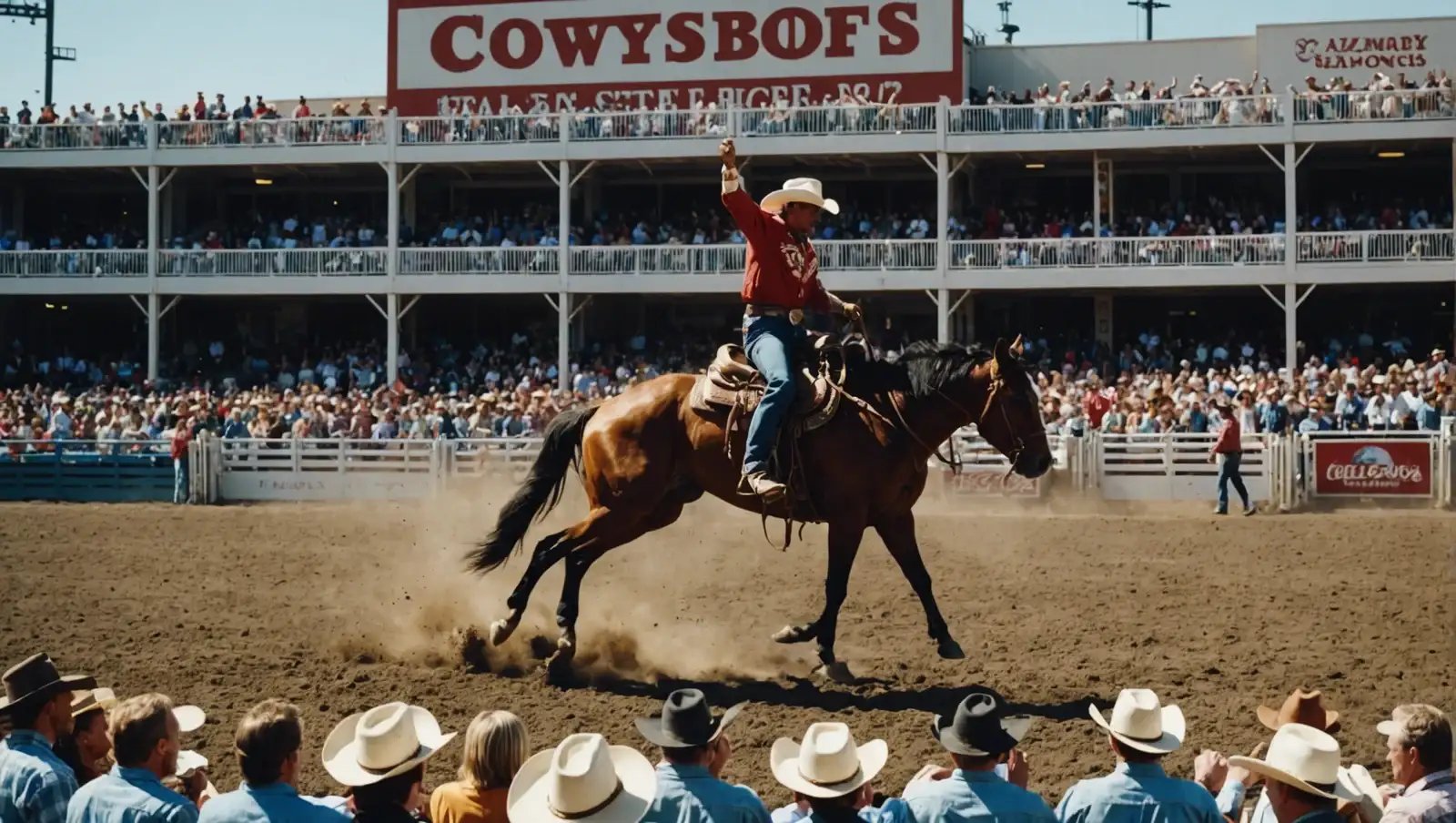Calgary Stampede Canada

Calgary, known for its vibrant cultural scene and rich western heritage, hosts one of the most exhilarating and iconic events in Canada – the Calgary Stampede. This annual extravaganza, billed as “The Greatest Outdoor Show on Earth”, combines thrilling rodeo action, lively exhibitions, and vibrant festivities that draw over one million visitors each year.
From heart-stopping chuckwagon races to world-class concerts, the Stampede offers a unique blend of entertainment, celebrating the city’s deep-rooted cowboy culture and showcasing the best of Canadian talent.
Key Takeaways:
- Calgary Stampede: The Calgary Stampede is an annual rodeo, exhibition, and festival held every July in Calgary, Alberta, Canada, attracting over one million visitors per year.
- Historical Roots: The event originated in 1886 and has evolved over the years, merging with the Calgary Industrial Exhibition in 1923 to become the Calgary Exhibition and Stampede.
- Significance: The Calgary Stampede is a major tourist attraction, showcasing rodeo events, chuckwagon races, agricultural displays, concerts, and First Nations exhibitions, playing a key role in the city’s culture and identity.
History
Even before its induction into the ProRodeo Hall of Fame in 2008, the Calgary Stampede had a rich history dating back to 1886. The roots of this iconic event can be traced to the Calgary and District Agricultural Society’s first fair, which attracted a quarter of the town’s residents. In 1912, American promoter Guy Weadick organized the first Stampede, which successfully showcased the essence of the “wild west.”
The event further evolved in 1919 with the “Great Victory Stampede,” celebrating Canada’s soldiers returning from World War I.
Calgary Exhibition and Stampede
The Calgary Exhibition and Stampede officially came together in 1923, merging two prominent events of the time. This union saw the introduction of the new sport of chuckwagon racing, which immediately captured the public’s interest. The annual event, supported by civic leaders and volunteers, quickly became a significant attraction, drawing large crowds and generating substantial revenue.
Over the years, the Exhibition and Stampede solidified its place as one of Canada’s largest festivals, embodying the spirit of the “Wild West” and celebrating Alberta’s ranching and agricultural heritage.
Expansion and Development
To accommodate the growing popularity of the Stampede and the increasing number of attendees, Stampede Park underwent significant expansion and development in the 1950s. The construction of the Stampede Corral, featuring the largest indoor arena in Western Canada, along with improvements to the grandstand and race track, enhanced the overall experience for visitors.
The park continued to evolve, adding new facilities like the Big Four Building, an exhibition hall serving as a hub for various events. These developments transformed Stampede Park into a vibrant year-round destination, attracting millions of visitors each year.
To succinctly put into perspective, by the 1970s, attendance at the Stampede surpassed half a million, leading to the extension of the event from six to ten days. The continuous growth saw the addition of modern venues like the Round-Up Centre and the iconic Olympic Saddledome, elevating the Stampede’s stature as a must-visit cultural and sporting extravaganza in Canada.
The Impact of Flooding
Understanding the challenges of adverse weather conditions, the 2013 Stampede faced a setback with severe flooding just weeks before its scheduled opening. Despite the significant damage caused, organizers remained committed to staging the event as planned to uphold the longstanding traditions and spirit of the Calgary Stampede.
While some events and concerts were affected due to flood-related issues, the resilience and determination of the Stampede community shone through during this challenging time.
Adaptations during the COVID-19 Pandemic
With the world grappling with the unprecedented COVID-19 pandemic, the 2020 Stampede faced its first cancellation in almost a century to prioritize public health and safety. However, the Stampede spirit persevered with innovative community-oriented events ensuring a touch of Stampede magic was still experienced despite the challenging circumstances.
The economic impact of the cancellation underscored the deep connection and financial significance of the event to the region.
Events
Opening Parade
One of the most exciting events at the Calgary Stampede is the Opening Parade. With a rich history dating back to the first Stampede in 1912, the parade serves as the official kick-off to the festivities. It features a colourful display of marching bands, floats, horses, and various dignitaries.
The parade marshal, selected each year, adds a special touch to the event, making it a must-see for visitors and locals alike.
Rodeo Competitions
Not only is the Calgary Stampede known as “The Greatest Outdoor Show on Earth,” but its rodeo competitions are also legendary. The roots of the rodeo at the Stampede date back to its inception in 1912, and since then, it has grown into one of the largest and most prestigious rodeos in the world.
Cowboys and cowgirls from around the globe come to compete in events like bull riding, barrel racing, and steer wrestling, all vying for the coveted prize money and the title of Stampede champion.
History: The rodeo competitions at the Calgary Stampede have a long and storied history dating back to its early days. What started as a small event in 1912 has evolved into a world-class rodeo attracting top talent and large crowds.
Rangeland Derby
Participants: The Rangeland Derby, also known as the chuckwagon racing, is a fan-favourite event at the Calgary Stampede. Originating in 1923, this thrilling race features chuckwagon drivers competing for a substantial prize purse. The event has grown in popularity over the years, drawing large crowds and showcasing the skill and agility of both the drivers and their horses.
The chuckwagon racing tradition at the Stampede has become a highlight for many attendees, capturing the essence of the Wild West and showcasing the adrenaline-pumping excitement of the sport.
Exhibition
The exhibition at the Calgary Stampede is a crucial component of the event, offering visitors a glimpse into Alberta’s agricultural heritage and modern food production. From livestock showcases to blacksmith competitions, the exhibition highlights the rich agricultural traditions of the region, educating and entertaining attendees of all ages.
Midway Attractions and Entertainment
The midway at the Calgary Stampede is a hub of excitement and entertainment. With thrilling rides, carnival games, and live music performances, the midway offers a vibrant atmosphere for visitors to enjoy. Whether you’re seeking an adrenaline rush or simply want to soak in the festive ambience, the midway has something for everyone.
Marketplace
The marketplace at the Stampede offers a diverse range of shopping experiences, from Western-themed artwork to artisanal crafts and local delicacies. With a focus on promoting local talent and products, the marketplace provides a unique shopping experience for visitors looking to take home a piece of the Stampede spirit.
Stampede Park
Location and Facilities
For the Calgary Stampede in Canada, Stampede Park serves as the hub of activities and celebrations. Located southeast of downtown Calgary in the Beltline District, the park is easily accessible via Calgary Transit’s light rail system.
The park boasts a range of permanent structures including the iconic Saddledome, Big Four Building, BMO Centre, Cowboys Casino, Stampede Grandstand, agriculture building, and other facilities that support the exhibition and livestock shows.
Year-Round Operations and Usage
Year-round, Stampede Park remains a central gathering place for Calgarians and tourists alike. Beyond the ten-day Calgary Stampede event, over 2.5 million people attend various other sporting events, concerts, trade shows, and meetings held on the park’s grounds every year. The park hosts over 1,000 events annually, showcasing its versatility and significance in the city’s social and cultural calendar.
To ensure the park’s continuous engagement with the community, initiatives like the Young Canadians of the Calgary Stampede provide professional training opportunities to young performers. The park’s year-round programming reflects its commitment to fostering talent and entertaining audiences, making it a vibrant and dynamic destination throughout the seasons.
Upgrades and Improvements
To enhance visitor experience and modernizing facilities, Stampede Park has undergone significant upgrades and improvements over the years. For instance, expansions like the Stampede Corral, Big Four Building, BMO Centre, and the Olympic Saddledome have contributed to the park’s growth and evolution.
These enhancements have not only catered to the increasing attendance numbers but also positioned Stampede Park as a premier events venue in Western Canada.
For instance, the introduction of new venues like The Big Four Roadhouse has added to the diversity of offerings at the park, ensuring that there is something for everyone to enjoy.
The ongoing commitment to upgrades and improvements underscores Stampede Park’s dedication to providing world-class facilities for both visitors and performers, continuing its legacy as a key cultural landmark in Calgary.
People of the Stampede
Despite the longstanding traditions and immense popularity of the Calgary Stampede, it is the people who bring life and vibrancy to this iconic event. From participants to volunteers, the Stampede is a celebration of community, culture, and dedication.
First Nations Participation and Representation
First Nations participation and representation have been integral to the Calgary Stampede since its early days. The five nations of Treaty 7 played a significant role in the event, showcasing their traditions, art, and way of life at the Elbow River Camp. Through pow-wows, tipi displays, and cultural performances, they offer visitors a glimpse into their rich heritage.
Employment and Volunteer Opportunities
On the operational side, the Stampede provides employment opportunities for over 300 full-time and 1,400 part-time employees throughout the year. An additional 3,500 seasonal workers are hired during the event itself. However, it is the legion of volunteers that truly make the Stampede possible, with over 2,000 volunteers serving on various committees responsible for every aspect of the event.
A significant portion of the volunteers have dedicated years, if not decades, to the Stampede, showcasing their unwavering commitment to this cherished tradition. The board of directors, comprised of a diverse group of individuals, plays a pivotal role in guiding the organization and ensuring the success of the event year after year.
Youth Involvement
Youth involvement at the Calgary Stampede is encouraged through programs like the Young Canadians School of Performing Arts, offering professional training to aspiring singers and dancers.
The Young Canadians of the Calgary Stampede have been a beloved part of the event since the 1960s, showcasing local talent and adding an energetic flair to the grandstand shows.
The Stampede not only celebrates Western heritage but also provides a platform for diverse communities to come together and share their stories. Through youth programs, volunteer opportunities, and the active participation of First Nations peoples, the Stampede embodies a spirit of inclusivity and collaboration that defines its enduring legacy.
Economic Impact
Contribution to the Local Economy
Many festivals around the world have a significant economic impact on their host cities, and the Calgary Stampede is no exception. The event contributes immensely to the local economy, injecting millions of dollars annually.
Recent editions of the Stampede have contributed around $540 million to the province’s economy. This substantial financial input helps support various businesses, from hotels and restaurants to local vendors and service providers, creating a ripple effect of economic growth and prosperity throughout the region.
Tourism and International Attention
An integral part of the Calgary Stampede’s impact is its influence on tourism and international attention. Drawing over one million visitors per year, the Stampede is one of Canada’s largest festivals, attracting individuals from all over the world. This influx of tourists not only boosts the local hospitality industry but also puts Calgary on the map as a must-visit destination.
Additionally, the Stampede’s international recognition, with events televised across Canada and beyond, helps showcase the city’s unique culture and traditions to a global audience.
For an event that bills itself as “The Greatest Outdoor Show on Earth,” the Calgary Stampede certainly lives up to its reputation. The combination of its significant economic contributions to the local economy along with its role as a major tourist attraction and international spectacle highlights the immense impact the Stampede has on both Calgary and the broader cultural landscape.
With millions of dollars in economic activity, a massive influx of visitors, and global recognition, the Stampede continues to be a powerhouse event that leaves a lasting impression on all who attend.
Controversies and Challenges
Animal Welfare Concerns
All aspects of the Calgary Stampede, including the rodeo events and chuckwagon races, have faced scrutiny and criticism from animal welfare groups and politicians concerned about the treatment of animals in such events. International criticism has been increasing, with calls to ban rodeo events altogether due to concerns over the well-being of the animals involved.
The Stampede’s use of animals in competitions has been a contentious issue, with some arguing that traditional events may be harmful or stressful for the animals.
Environmental Impact
The Calgary Stampede, with over one million visitors per year and numerous events spread across the city, has a significant environmental impact. The large crowds, transportation, and various activities can contribute to waste generation, increased energy consumption, and strain on local resources.
Additionally, the infrastructure and development associated with the Stampede grounds may have effects on the surrounding environment.
The environmental impact of the Calgary Stampede goes beyond the event itself. The growth and expansion of Stampede Park, as well as the associated urban renewal projects, can have lasting effects on the local ecosystem.
Issues such as increased traffic, waste disposal, and energy consumption are all factors that need to be considered in the overall environmental assessment of the event.
Responses and Measures for Improvement
In response to the concerns raised about animal welfare and the environmental impact of the Calgary Stampede, organizers and stakeholders have taken various measures to address these issues.
Efforts have been made to enhance animal care practices, ensure the well-being of the animals involved, and implement sustainable practices to reduce the event’s environmental footprint.
The welfare of the animals remains a top priority for the Stampede, with ongoing evaluations and improvements to ensure their safety and comfort during the various competitions.
To wrap up
Drawing together the rich history and cultural significance of the Calgary Stampede in Canada, it is evident that this annual event holds a special place in the hearts of Calgarians and visitors alike. From its humble beginnings in 1886 to becoming one of the world’s largest rodeos and festivals, the Stampede has grown into a significant tourist attraction and a symbol of Western heritage.
The event’s commitment to showcasing cowboy traditions, First Nations culture, agricultural excellence, and entertainment continues to captivate audiences year after year.
Despite challenges such as the recent cancellations due to the COVID-19 pandemic, the Stampede remains a beloved tradition that unites communities, celebrates diversity, and honours the spirit of the Wild West. The Calgary Stampede truly stands as a testament to the enduring legacy of Western culture in Canada.
Frequently Asked Questions
Q: What is the Calgary Stampede?
A: The Calgary Stampede is an annual rodeo, exhibition, and festival held every July in Calgary, Alberta, Canada. It is known as “The Greatest Outdoor Show on Earth” and attracts over one million visitors per year.
Q: When did the Calgary Stampede begin?
A: The roots of the Calgary Stampede can be traced back to 1886 when the Calgary and District Agricultural Society held its first fair. In 1912, American promoter Guy Weadick organized his first rodeo and festival, known as the Stampede, which has since become an annual event.
Q: What are some of the main events at the Calgary Stampede?
A: The Calgary Stampede features one of the world’s largest rodeos, a parade, midway, stage shows, concerts, chuckwagon racing, agricultural competitions, and First Nations exhibitions. It is a significant tourist attraction for the city and a celebration of western heritage.






